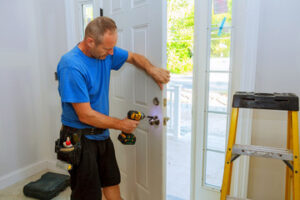Window Installation is a meticulous process that requires experience and precision. Proper preparation is key to a smooth, durable finish that will keep your home insulated and protected from water and outdoor elements.

Check the window opening to make sure it’s square and level, then frame the new window according to manufacturer instructions and industry best practices. Insulate the window and close it with a weather strip to prevent air leaks. Visit https://www.windowinstallationwaukesha.com/ to learn more.
When you install a new window, it is important to properly prepare the opening. This process will ensure that the window is installed correctly and sealed against moisture, air, and other outdoor elements. It will also help to prevent future problems such as rotting, water damage, and poor performance of the window.
The first step in preparation is to measure the rough opening of the wall where you want to install your new window. Be sure to measure at multiple points, and check that the measurements are accurate. If there is any significant difference, you may need to adjust the window size or choose a different window.
Next, you will need to remove any furniture, decorations, or other items from the area where the installers will be working. This will create a clear path for them and help to protect your belongings from dust, debris, or damage. You should also move any obstacles outside of the installation area, such as garden tools or furniture, and trim back any plants or bushes that could be in the way of the installation process.
Once the space is clear, you should cover any items that you don’t want covered in construction dust with drop cloths. It is also a good idea to cover your carpets and other flooring with tarps or sheets. This will keep them from getting dirty and help to preserve their longevity.
When the installation team arrives at your home, they will need to set up their work stations and begin the process of preparing the window opening. They will use a ladder to access the window sill and frame, and they will also need to remove any existing hardware from the window sashes or casing. This will include the sash weights and springs, as well as any other hardware that was used in previous windows.
It is a good idea to wait to make major improvements in your home, such as painting or changing flooring, until after the window has been installed. This will help to prevent damage and avoid any unnecessary delays in the project.
Measurement
When it comes to window replacement, precise measurements are essential. Even a small mismeasurement can throw off the installation and impact performance. It’s important to take the time to carefully prepare for measurement and ensure that you have a reliable tape measure, a level, and a notepad for recording your measurements. Before you start measuring, make sure the work area is clear and free of any obstructions that could skew your results. It’s also a good idea to clean the window area to provide better visibility and reduce the risk of error.
The first step in the measurement process is to determine the width of the existing window frame. This can be done by measuring across the inside surface of one jamb and across to the inside surface of the opposite jamb. Do this on the left, middle, and right sides of the window, using the smallest measurement to ensure that the new replacement windows will fit.
Next, you’ll need to determine the height of the window frame. This is a little more complicated, as you’ll need to measure across the sill (the bottom of the frame where the sash rests when closed) on the left, middle, and right sides. Again, use the smallest measurement to ensure that the new window will fit in the opening.
After that, you’ll need to determine the rough opening size of the window. This is the dimensions of the space within your wall, and it’s typically a half-inch larger than the actual window frame to account for adjustments and insulation.
This measurement is essential because it tells the window installers what kind of frame you have and how much room they have to work with. This helps them avoid wasting your hard-earned money on replacement windows that won’t fit in the opening or need to be trimmed to get in place. This is especially important if you’re replacing windows in an older home that may have settled and not be perfectly square. It’s also an excellent opportunity to communicate any special instructions for the install crew such as conserving your old windows or trimming, preserving your treatments, or avoiding a certain part of the yard that needs to be protected during installation.
Materials
Proper window framing is vital to the integrity of your home, preventing air leaks and contributing to energy efficiency. It’s important to use the right materials, follow modern standards and techniques for framing, and install windows with high insulating values to maximize your energy savings.
Before beginning any framing project, it’s essential to carefully measure the window opening to ensure accurate measurements and a smooth installation process. Using measuring tape and a carpenter’s square is a good way to make sure your measurements are precise. It’s also important to double-check your measurements to ensure they are accurate. If your measurements are off, the new window may not fit properly or could cause air leaks and reduced energy efficiency.
If you are replacing existing windows, it’s a good idea to test for lead paint in older homes to protect yourself and your family from potential health risks. Use a home lead testing kit or send a paint sample to a lab for testing. Additionally, wear protective gear and work in a well-ventilated area when removing old window trim and sills to avoid breathing in paint particles or lead dust.
When installing new windows, it’s important to follow the manufacturer’s instructions for your specific product. Different manufacturers have varying installation methods, so be sure to read the instructions thoroughly before beginning your project. If you have any questions, contact the manufacturer directly for assistance. Some manufacturers even offer online video installation resources that make it easier for visual learners to understand the process.
Once your windows are installed, you can install blinds or other window treatments to complete the look of your home. For example, if you have a valance over the window, mark where the first bracket will be on the wall with a pencil. Next, measure up 4 inches from each end of the valance and place a bracket at those marks. Finally, snap the valance onto the brackets to finish the job.
For a more dramatic renovation, consider full frame replacement windows. This method involves removing the entire window frame and sash, including any existing trim, to identify and resolve underlying issues such as moisture damage or poor insulation.
Installation
The window installation process is very complex and requires the use of specialised tools. However, with proper preparation and the right materials, even do-it-yourself enthusiasts can successfully install windows themselves. To start, it is important to clear the work area of any furniture or objects that may be in the way during the installation. This will protect the surfaces from damage and make the work easier for both you and the installers.
It is also a good idea to cover the furniture with sheets that will prevent dust and debris from ruining your upholstery. In addition, this will help you avoid expensive repairs to your furniture. You should also remove any outdoor objects that could be damaged during the window installation. This includes garden furniture, barbecues, and flowerpots. If you have children or pets, it is a good idea to keep them away from the work area, as they may be curious about the heavy materials and loud tools that are being used.
After the window is inserted, it should be checked for alignment and fastened to the wall. If necessary, the gap between the window and the frame should be insulated with fiberglass or low-expanding foam insulation. Caulking is then applied around the perimeter of the window to create a watertight seal. In some cases, a backer rod may be used to reduce the amount of caulk needed and improve the quality of the installation.
When the installation is complete, it is important to check that the windows are properly adjusted and the seals are correctly in place – this will ensure the smooth operation of the window sash and guarantee thermal and acoustic insulation. Furthermore, well-adjusted windows and front doors are better insulated and provide greater resistance to moisture and condensation.
If you are planning to hire a contractor for the window installation, be sure to discuss their pricing policy in advance. Some contractors will charge extra if they have to ask for your physical help lifting large or heavy windows into place, so you should clarify this matter in advance. It is also a good idea to find out how long the project will take, so that you can plan your day and make arrangements for your children and pets.
